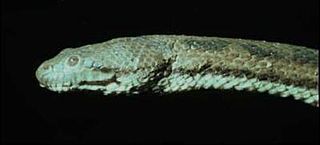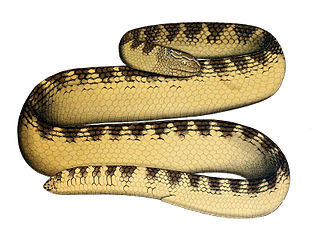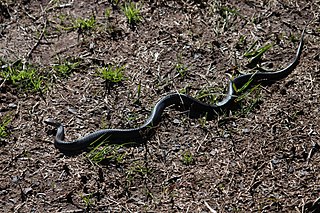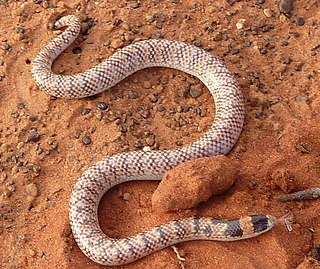
Elapidae is a family of snakes characterized by their permanently erect fangs at the front of the mouth. Most elapids are venomous, with the exception of the genus Emydocephalus. Many members of this family exhibit a threat display of rearing upwards while spreading out a neck flap. Elapids are endemic to tropical and subtropical regions around the world, with terrestrial forms in Asia, Australia, Africa, and the Americas and marine forms in the Pacific and Indian Oceans. Members of the family have a wide range of sizes, from the 18 cm (7.1 in) white-lipped snake to the 5.85 m king cobra. Most species have neurotoxic venom that is channeled by their hollow fangs, and some may contain other toxic components in various proportions. The family includes 55 genera with around 360 species and over 170 subspecies.

Aspidites is a genus of pythons endemic to Australia. The name can be translated as "shield bearer" and pertains to the symmetrically shaped head scales. Currently, two species are recognized.

The Homalopsidae are a family of snakes which contains about 30 genera and more than 50 species. They are commonly known as Indo-Australian water snakes, mudsnakes, or bockadams. They are also known as ular air in Indonesian. They are typically stout-bodied water snakes, and all are mildly venomous. Two monotypic genera are notable for their unusual morphology: Erpeton possesses a pair of short, fleshy appendages protruding from the front of the snout, and Bitia has uniquely enlarged palatine teeth. Cerberus species have been noted to use sidewinding to cross slick mud flats during low tide. Fordonia and Gerarda are the only snakes known to tear their prey apart before eating it, pulling soft-shelled crabs through their coils to rip them apart prior to ingestion.

The eastern brown snake, often referred to as the common brown snake, is a species of extremely venomous snake in the family Elapidae. The species is native to eastern and central Australia and southern New Guinea. It was first described by André Marie Constant Duméril, Gabriel Bibron, and Auguste Duméril in 1854. The adult eastern brown snake has a slender build and can grow to 2 m (7 ft) in length. The colour of its surface ranges from pale brown to black, while its underside is pale cream-yellow, often with orange or grey splotches. The eastern brown snake is found in most habitats except dense forests, often in farmland and on the outskirts of urban areas, as such places are populated by its main prey, the house mouse. The species is oviparous. The International Union for Conservation of Nature classifies the snake as a least-concern species, though its status in New Guinea is unclear.

Aipysurus eydouxii, commonly known as the beaded sea snake, the marbled seasnake, and the spine-tailed seasnake, is a species of venomous snake in the family Elapidae. A. eydouxii is unusual amongst sea snakes in that it feeds almost exclusively on fish eggs. As part of this unusual diet, this species has lost its fangs, and the venom glands are almost entirely atrophied.

Sea snakes, or coral reef snakes, are elapid snakes that inhabit marine environments for most or all of their lives. They belong to two subfamilies, Hydrophiinae and Laticaudinae. Hydrophiinae also includes Australasian terrestrial snakes, whereas Laticaudinae only includes the sea kraits (Laticauda), of which three species are found exclusively in freshwater. If these three freshwater species are excluded, there are 69 species of sea snakes divided between seven genera.

Walterinnesia is a genus of venomous snakes in the family Elapidae. The genus contains two species, known commonly as desert black snakes or black desert cobras, which are endemic to the Middle East. The generic name Walterinnesia honours Walter Francis Innes Bey (1858–1937), who was a physician and zoologist in Egypt.

Hydrophis is a genus of sea snakes, venomous snakes in the subfamily Hydrophiinae of the family Elapidae. Species in the genus Hydrophis are typically found in Indo-Australian and Southeast Asian waters. Currently, around 36 species are recognized as being valid.

Sea kraits are a genus of venomous elapid sea snakes, Laticauda. They are semiaquatic, and retain the wide ventral scales typical of terrestrial snakes for moving on land, but also have paddle-shaped tails for swimming. Unlike fully aquatic ovoviviparous sea snakes, sea kraits are oviparous and must come to land to digest prey and lay eggs. They also have independent evolutionary origins into aquatic habitats, with sea kraits diverging earlier from other Australasian elapids. Thus, sea kraits and sea snakes are an example of convergent evolution into aquatic habitats within the Hydrophiinae snakes. Sea kraits are also often confused with land kraits , which are not aquatic.

Aipysurus is a genus of venomous snakes in the subfamily Hydrophiinae of the family Elapidae. Member species of the genus are found in warm seas from the Indian Ocean to the Pacific Ocean.

The yellow-faced whip snake is a species of venomous snake in the family Elapidae, a family containing many dangerous snakes. D. psammophis is endemic to Australia, found throughout the continent in a variety of habitats from coastal fringes to interior arid scrubland.

The forest cobra, also commonly called the black cobra and the black and white-lipped cobra, is a species of highly venomous snake in the family Elapidae. The species is native to Africa, mostly the central and western parts of the continent. It is the largest true cobra species with a record length of 3.2 metres.

Micruroides is a genus of venomous coral snake in the family Elapidae. The genus is monotypic, containing only the species Micruroides euryxanthus.

Emydocephalus annulatus, commonly known as the turtleheaded sea snake or egg-eating sea snake, is a species of sea snake that can be found in waters of Oceania near Australia and some Pacific Islands such as the Philippines and the Loyalty Islands of New Caledonia. The geographic range is sporadic, for example, with populations distributed near the eastern and western coasts of Australia in the Great Barrier Reef and the Timor Sea reefs, respectively. They do not, however, occur in the Gulf of Carpentaria along the north coast.

Hemiaspis is a genus of venomous snakes of the Elapidae family. The genus has two described species: Hemiaspis damelii and Hemiaspis signata, both endemic to Australia.

Anchieta's cobra, sometimes referred to as the Angolan cobra, is a species of venomous snake in the family Elapidae. The species is native to Southern Africa.

Emydocephalus ijimae, also called Ijima's sea snake and turtleheaded sea snake, is a species of snake in the family Elapidae. The species occurs in East Asia, in the shallow coastal waters of the Northwest Pacific Ocean. E. ijimae feed exclusively on the eggs of coral reef fishes, which makes them an important predator for maintaining a healthy coral reef ecosystem.

Brachyurophis fasciolatus is a species of snake from the family Elapidae, commonly named the narrow-banded shovel-nosed snake, or narrow-banded burrowing snake, and is a species endemic to Australia. Its common names reflect its shovel nose specialization, burrowing behaviour and banded body colour.
Aipysurus mosaicus is a species of snake found in coastal seas of Australia. It is commonly known as the mosaic sea snake.
Emydocephalus orarius, also known as the white-crowned sea snake or white-naped sea snake, is a species of elapid sea snake endemic to Australian waters. The specific epithet orarius (“coastal”) refers to its known habitat.


















